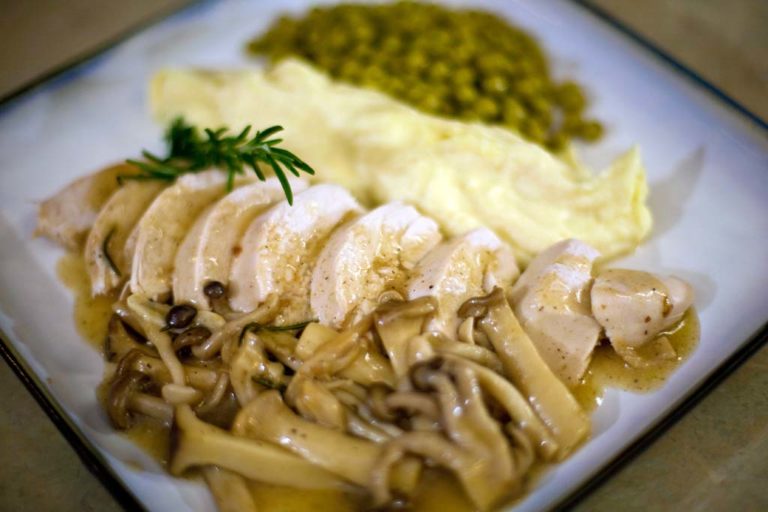
Chef's notes:
Poaching a chicken is not like boiling a chicken. Poaching is cooking something submerged in a liquid at or below 180 degrees F. Some people say 185, but I think that’s too hot. Perhaps the best way to poach is to bring the liquid to the temperature you are aiming for—like 160 for chicken—and poach at that temperature. That way you can never overcook it because the cooking medium (the poaching liquid) can’t get any hotter. I know, brilliant right? It may take a little longer to cook, but not as long as you may think. Liquid transfers heat very efficiently.
Ingredients
- 1 broiler chicken
- 8 cups chicken stock
- 4 cups dry white wine
Whole Chicken Trussed and Slowly Poached in White Wine and Stock at 180 F
- Prep a chicken for poaching. Buy a broiler or roaster hen from your local butcher or farm. When you get it home give it a rinse in cold water. Pat it dry with paper towels. Use butcher’s twine to truss the chicken (tie up the legs and wings). Tie a loop at the legs to use as a handle for putting the chicken in the pot.
- Heat up the poaching liquid. Use a good thermometer to track the temperature of the poaching liquid. This is crucial. Heat up the poaching liquid to 180 degrees F before putting in the chicken. Once the chicken is in the liquid keep the temperature between 175 and 180 degrees F. Just stay in the kitchen and keep checking the temp. You don’t want it to get too hot.
- Poach the chicken. If the poaching liquid gets low, add a little hot water. Poaching temperature is just below simmering temperature. So don’t let it break into a boil—even a gentle one. After an hour check the internal temperature of the chicken. This chicken took approximately one and a half hours to get to 160 degrees F. I took its temperature in the thick part of the thigh.
- Let the poached chicken rest. Once the chicken is up to 160 degrees F, remove it from the poaching liquid. Let it drain for a few moments over the pot before you transfer it to the wire rack to drain and cool. Loosely cover it with aluminum foil and let it sit for thirty minutes. Make sure the draining liquid has somewhere to go. After the chicken rests, cut up and serve with your favorite sauce. Don’t forget to use some of the poaching liquid for the sauce.
Tips & Tricks
- Buy a fat chicken or hen for this recipe. Leave those skinny roosters for stewed chicken.
- The trussing or tying is not absolutely necessary. It just makes it easier to move the chicken around.
- Make sure the pot you are using is big enough to hold the chicken and the liquid, or enough liquid to cover the chicken. As you can see, this pot was filled to the brim. But since the surface remained calm during cooking, it didn’t spill over.
- It’s important to keep a thermometer in the poaching liquid for the duration of the poaching process. If the temperature isn’t at or below 180 degrees F, it isn’t really poaching—it’s simmering or boiling.
- Stay near the poaching chicken while it’s in the pot. You don’t want to leave the room until you know for sure that the temperature is stable. Electric stovetops are unreliable in their consistency.
- Remove the skin from the poached chicken before it’s served. It isn’t very appetizing.
Mushroom Sauce Recipe
- 4 cups assorted mushrooms
- 3 cloves garlic, slivered
- 2 Tbsp butter
Saute mushrooms and garlic in butter until the garlic gets brown. Deglaze the pan with 2–3 cups of poaching liquid. Thicken with 1 Tbsp cornstarch mixed into 2 Tbsp of cool water. Cook for a minute on low after it’s thickened. Adjust the seasoning and serve with the poached chicken.
